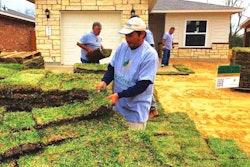 Lawns left untreated can start to see crabgrass appear if drought causes the yard to thin out.
Lawns left untreated can start to see crabgrass appear if drought causes the yard to thin out.Photo: Zac Reicher, Bayer
Most landscapers know that if they want to keep crabgrass under control, they need to apply a pre-emergent herbicide; but, when it comes to details, there are some confusing misconceptions floating out there.
The Internet is often where one turns when looking for answers, and while there is plenty of sound information to be found there, you’ll also find a fair amount of conflicting concepts.
To set the record straight on these myths, we talked to several field scientists about commonly-held fallacies, whether by customers or lawn-care providers.
#1 No prior issues, no need for pre-emergents
Some sources will claim that if weeds have been controlled for the past few years, the supply of weed seeds in the soil will be depleted and therefore there is no longer a need to apply pre-emergent herbicides.
If your customer’s house were inside a bubble, this might hold true, but crabgrass seeds can be transported great distances by the wind or animals, so it’s best to treat the yard.
“You don’t know what your neighbors did, if anything, and weed seed spreads easily,” said Dan Loughner, a field scientist for Dow AgroSciences Turf and Ornamental.
Weed seeds are viable for a long time in the soil so it’s better to treat the yard with pre-emergents and avoid upset customer phone calls when the crabgrass begins to appear.
#2 Thick lawns don’t need to be treated
While it is true that thick, healthy lawns are able to shade the soil surface and reduce crabgrass germination there is no guarantee that the lawn will be able to maintain its lushness throughout spring and summer.
 Crabgrass often fails to germinate when it is shaded by a healthy lawn.
Crabgrass often fails to germinate when it is shaded by a healthy lawn.Photo: Zac Reicher, Bayer
“Crabgrass generally won’t survive because of the competition from a healthy lawn,” said Zac Reicher, a Bayer Green Solutions Team specialist. “It can’t compete very well. But, if the lawn thins out during the summer due to drought or some other stress, you may start to see crabgrass.”
Proper fertilization, mowing, irrigation and soil aerification are all key for creating a dense lawn, but sometimes events beyond your control can cause the lawn to thin out.
Applying a pre-emergent herbicide can serve as an insurance policy on the off chance the yard suddenly loses its luster.
#3 Soil aeration breaks the pre-emergent control barrier
Because pre-emergent herbicides create a barrier in the soil, it is a commonly-held belief that aeration will disrupt this layer, defeating the purpose of the herbicide application.
However, according to Dean Mosdell, a field technical manager for Syngenta, there have been several published research articles that demonstrate no reduction of weed control with spring aeration.
“I could see that tine aeration might be acceptable since the area disrupted is small but in the case of core aeration I would have some concern with the amount of soil being removed from a given area,” Loughner said.
Reicher points out that lawn care companies shouldn’t be deliberately aerating after applying pre-emergents, but research shows it won’t do too much harm if you need to.
“When you look at a lawn care company, clients sometimes don’t treat their lawns the way you might recommend,” Reicher said. “If they end up wanting spring aeration after the herbicide has been applied, you can go back in and aerate, but I wouldn’t do it intentionally on all of your lawns.”
#4 Spot-treating is more effective
You may think you’re saving your client and your company some money by offering to treat only the hot spots, such as along the driveway and sidewalks, but the consensus among scientists is that this method is ineffective.
“It is better to treat the entire yard with a pre-emergent herbicide,” Loughner said. “A broadcast application will help reduce the risk of weed breakthrough later in the season.”
Because pre-emergent herbicides are usually applied as a granular combined with fertilizer, spot-treating isn’t practical when using this formulation.
“Best practice may be to treat the entire yard and take special note of the areas beside sidewalks to prevent call-backs,” said Mosdell.
#5 Post-emergent herbicides are better
If you are looking for the cheaper and easier option for controlling crabgrass, beating it to the punch by putting down a pre-emergent is the way to go.
“Post-emergence control of annual grasses is generally less effective, has a greater risk of injury to desirable turf and may require multiple applications,” Mosdell said.
 Dan Loughner
Dan LoughnerMeanwhile, pre-emergent herbicides have very little chance of affecting the established turf and require far fewer applications. An added bonus: pre-emergent applications are easier to schedule because the products won’t degrade if applied early.
“Early applications allow the turfgrass to achieve a fuller canopy,” Loughner said. “Waiting for weeds to appear could result in apparent voids in the turf where weeds existed. Grass takes longer to fill in than weeds. Waiting to see weeds is unsightly and property owners may become annoyed.”
#6 Pre-emergents must be applied at an exact time
There are several timing factors that people tend to go by, either waiting for a specific month depending on their region or monitoring soil temperatures. Crabgrass starts to germinate when the soil temperature has been above 50 degrees for several days.
The most important thing is to remember that it is better to apply early than too late.
“There is significantly more room on the front side of a pre-emergence application, because products like Specticle will maintain high efficacy through the season – even if applied a little early,” Reicher said. “This helps lawn care companies have a larger window to apply preventatively.”
It’s important to understand that pre-emergent herbicides aren’t stopping the seeds from germinating, but rather it inhibits root and shoot development.
“Another misconception is that they are root pruners, Mosdell said. “Only new rooting initiated from above the herbicide barrier is inhibited, not existing roots below the shallow herbicide barrier.”









